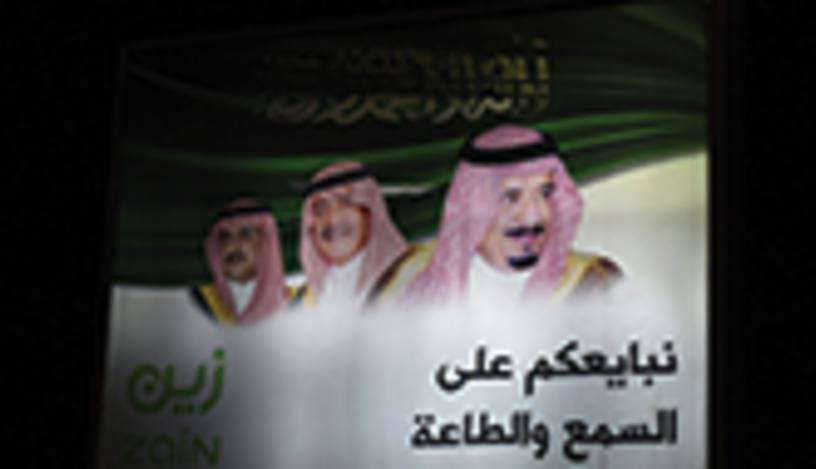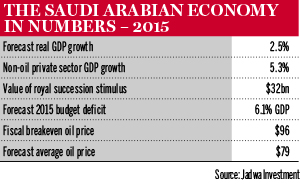In recent years, the major energy exporting economies of the Gulf have emerged as the most striking growth stories in the Middle East and North Africa region. Yet few of these stories have been as impressive, or as enduring, as Saudi Arabia’s. Today, the country is rightly recognised as one of the most dynamic and resilient economies anywhere in the world.
This position owes as much to the hard work and foresight of the government as it does to the country’s vast energy reserves, which have been employed so effectively. In shoring up the economy during the good times, through a combination of fiscal discipline and prudent financial regulation, the government has left Saudi Arabia better prepared than most to weather the challenges of the future.
A smooth transition
This foresight is now starting to pay off. In recent months Saudi Arabia has endured the twin challenges of a leadership transition and a dramatic drop in global oil prices. The death of the long-serving King Abdullah, a noted and admired reformer, has led to a successful succession to his half-brother, King Salman. Despite concerns over the outcome of this process, it was achieved with remarkable calm and ease.
“The transition of power from King Abdullah, who died on January 23, to Salman appears to have gone smoothly, a credit positive for Saudi Arabia. The naming of a new crown prince, Muqrin bin Abdulaziz, formerly deputy crown prince, and a new deputy crown prince, Mohammed bin Nayef, reinforce the continuity of the regime and institutional stability,” says Steven Hess, senior vice-president of ratings agency Moody’s.
Meanwhile, booming oil production from US shale caused a 61% drop in the price of crude oil between June and December 2014. Many expect this to be a defining moment for the global energy sector, as US shale producers assume the mantle of global swing supplier. The consensus outlook for Brent crude prices in 2015 sits somewhere between $70 and $80, while under medium-term scenarios this figure is expected to reach closer to $89.
This will offer a longer term challenge, as Saudi Arabia’s fiscal break-even point remains somewhat high relative to other Gulf Co-operation Council peers, including Qatar and Kuwait. Estimates of this price vary; according to Fitch Ratings it sits about $96, while Oxford Economics estimates it at $87. In either case, current spending patterns will be too high to maintain in what is shaping up to be a lower oil price environment.
The country's concentration risks in the hydrocarbons sector, a well known dilemma, will amplify this challenge over the next five years. With 90% of fiscal revenue and 80% of current account revenues sourced from oil production, there is a recognised need to diversify the economy. Here, the government has been working hard to promote the growth of the non-oil private sector with considerable success (see story on page 90).
Strong outlook
Nevertheless, to date both the royal succession and the drop in oil prices have minimally impacted Saudi Arabia’s economic trajectory. "The Saudi economy has been generating positive momentum for a number of years. This carried through to 2014 and helped to lift the performance of the country’s banks in particular,” says Dr Said Al-Shaikh, senior vice-president and group chief economist with the country’s largest lender, National Commercial Bank.
More encouragingly, Saudi Arabia’s medium-term economic prospects also look strong, thanks to its track record of prudent leadership and fiscal discipline. Fiscal surpluses have been recorded every year – except 2011 – since 2000. In tandem, impressive double-digit current account surpluses have also been achieved in 10 out of the past 11 years, according to research from Fitch Ratings.
Together with a substantial foreign currency stockpile, close to $730bn or 112% of gross domestic product (GDP), the country's economy is in enviable health. Meanwhile, domestic debt, at SR44.2bn ($11.79bn), equates to only 1.6% of GDP, leaving the government with a strong arsenal of financing options for the future.
The Saudi budget for the 2015 fiscal year, approved in late December 2014, signalled the government’s intention to continue to support the economy. For the first time since 2011, a fiscal deficit is projected with expected revenues of SR715bn against spending of SR860bn. Spending priorities, building on previous budgets, remain in the spheres of education and healthcare, which collectively account for 43.8% of anticipated government spending.
Nevertheless, annual expenditure figures tend to exceed official numbers in Saudi Arabia. Over the past decade, government spending has averaged about 25% higher than the budgeted figure, according to research from Jadwa Investment, a local privately held private investment firm. Jadwa expects to see a drop in overspending for the country's latest budget, to about 16%, forecasting total expenditure of SR1003bn.
This projected deficit will be financed through the substantial foreign currency stockpile held by the country's central bank, the Saudi Arabian Monetary Agency. “The government can continue current levels of spending for the next seven to eight years before depleting its current reserves. This will cushion the impact of the oil price drop on the local economy,” says Tariq Al Sudairy, chief executive of Jadwa Investment.
Still growing
On this basis, the outlook for economic growth in 2015 remains promising. "This year we are still expecting good growth, albeit at a moderately slower pace than 2014,” says David Dew, managing director of the Saudi British Bank.
According to figures from Jadwa Investment, GDP growth is expected to reach 2.5% in 2015, which is a decline from the 3.7% growth achieved in 2014. Yet, most of this contraction will be the result of the drop in oil prices, which is anticipated to shave a total of 0.6% off the country’s economic growth.
"While the broader economy will continue to perform well, backed by government spending, we can expect to see a contraction in margins for the oil and gas sector on the back of lower oil prices,” says Usman Iskander, managing director and head of investment banking at Saudi Fransi Capital.
Despite the challenge of lower oil prices, the country's new Yasref refinery – a 400,000-barrels-per-day joint venture between Saudi Aramco and Sinopec – and the Jubail refinery, which became active in 2014, are both expected to increase the economic contributions of Saudi Arabia's petroleum refining sector this year. Similarly, significant contributions from the country’s electricity and water sectors, non-oil manufacturing and wholesale and retail sectors will continue to underpin GDP growth for the year.
Moreover, King Salman has issued a $32bn stimulus package for the economy in the form of a two-month salary bonus for public sector employees and pensioners. This is expected to provide an additional and positive short-term boost to the non-oil private sector, with particular benefits anticipated for the country’s consumer and tourism industries.
These developments point to the strength of the Saudi model during a period of challenging political and economic circumstances. Though the country’s growth story is set to continue, more energy is now being directed towards long-standing programmes of labour market reform, economic diversification and development. In this environment, the role of Saudi Arabia’s banks has gained in significance, with many viewing the current oil price environment as an opportunity to implement lasting change.
"The decline in oil prices may provide an opportunity, as well as some challenges, for Saudi Arabia," says Mr Dew. "When you have a period of abundance, inefficiencies and complacency can creep in. Having a period where the country can reflect on how to improve the structure of the overall economy and improve the use of its abundant resources is not necessarily a bad thing.”













